

Criticism of the NOVA classification: who are the protagonists? Mélissa Mialon Departamento de Nutrição, Faculdade de Saúde Pública, Universidade de São Paulo (USP), São Paulo, Brazil Paulo Sêrodio School of Economics, University of Barcelona, Barcelona, Spain Fernanda Baeza Scagliusi Departamento de Nutrição, Faculdade de Saúde Pública, Universidade de São Paulo (USP), São Paulo, Brazil Keywords: ultra-processed food, corporate political activity, food industry, commercial determinants of health, non-communicable diseases Abstract.
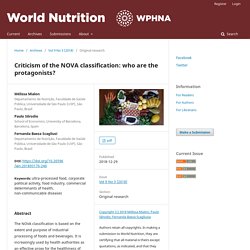
Diet, Nutrition, Physical Activity and Cancer: a Global Perspective. 2019: the year for nutrition. The Lancet entame une année dédiée à la nutrition. Les auteurs ont travaillé sur la relation entre régime alimentaire, santé humaine et durabilité environnementale, tous trois fortement liés, comme l'illustrent par exemple les impacts du changement climatique sur des réductions de rendements et, in fine, sur la sécurité alimentaire.

S'appuyant sur les connaissances scientifiques les plus récentes, ils se sont intéressés à la consommation finale et à la production, et proposent un « espace de fonctionnement sécurisé » (safe operating space), délimité par deux séries de cibles quantitatives : - des objectifs de consommation par grands groupes d'ingrédients, adaptables à une variété de pratiques locales (cf. figure ci-dessous) ; - des paramètres d'utilisation de six grandes entrées affectées par la production alimentaire : usages d'eau douce et des terres, pertes de biodiversité, émissions de gaz à effet de serre, pollutions azotées et phosphatées.
Source : EAT ; extraits CEP. Food in the Anthropocene: the EAT–Lancet Commission on healthy diets from sustainable food systems. The Global Syndemic of Obesity, Undernutrition, and Climate Change: The Lancet Commission report. Comprendre l’épidémiologie. Spécialiste de l’épidémiologie des maladies émergentes, Arnaud Fontanet a été invité par l’Assemblée du Collège de France à occuper pendant une année la chaire Santé publique, créée en partenariat avec Santé publique France.
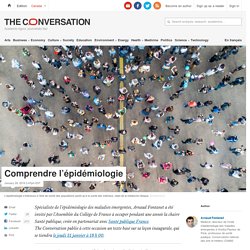
The Conversation publie à cette occasion un texte basé sur sa leçon inaugurale, qui se tiendra le jeudi 31 janvier à 18 h 00. Nous connaissons tous les méfaits du tabac, de l’alcool, d’une alimentation non équilibrée. Nous avons tous été sensibilisés au bénéfice du dépistage de l’hypertension artérielle, de certains cancers, ou de maladies infectieuses comme le SIDA. Mais saviez-vous que, pour pouvoir formuler ces recommandations, des scientifiques et des médecins ont suivi des dizaines de milliers d’individus, pendant plusieurs années ? Sans ces études épidémiologiques, impossible de connaître précisément la répartition des maladies au sein des populations, ou de déterminer quels sont les facteurs qui augmentent le risque de leur survenue.
Food allergies more widespread in adults than previously suspected, new study finds. About 26 million U.S. adults have food allergies, nearly half of which develop after age 18, according to a study published in JAMA Network Open.

The research, a collaboration between Stanford food allergy expert Kari Nadeau, MD, PhD, and scientists at Northwestern University, is the first comprehensive examination of the prevalence of food allergies among the country's adults. More than 40,000 people were surveyed. Many more adults have food allergies than previously suspected. The findings also contradict a long-held assumption that these allergies usually show up in childhood. Revue des travaux de recherche utilisant des données commerciales sur les achats alimentaires.
Publié dans la revue PLOS One en janvier 2019, un article s'intéresse à l'utilisation, pour des travaux de recherche en nutrition et santé publique, de données commerciales sur les achats de produits alimentaires et de boissons sans alcool. 69 articles en langue anglaise ont été sélectionnés.
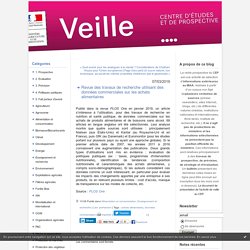
The use of commercial food purchase data for public health nutrition research: A systematic review. Effects of product reformulation on sugar intake and health—a systematic review and meta-analysis. Diet quality of vegetarian diets compared with nonvegetarian diets: a systematic review. Sorry. Shared Concerns and Opportunity for Joint Action in Creating a Food Environment That Supports Health. Socioeconomic Disadvantage across the Life Course Is Associated with Diet Quality in Young Adulthood. Digital diabetes? Nutrition-tech collaborations could make 'huge difference' in the future. Globally, more than 425 million people have diabetes and each year an estimated 1.6 million deaths are directly attributed to the chronic, metabolic disease, according to the World Health Organization (WHO).

Data from Statistica suggests there are an estimated 58 million diabetics in Europe and the global numbers will soar to 629 million by 2045. For those living with the disease, tracking and managing blood glucose levels is vital and technology has advanced significantly over the years, with most recent advancements shifting towards apps. Austria-founded mySugr, for example, which launched in 2012 and now has more than 1.4 million worldwide users, developed a diabetes tracking app to monitor vital numbers like blood sugar levels, basal rates and carbs, amongst others, throughout each day. Importantly, the app can be paired with a blood sugar testing device, enabling users to track vitals without any manual input. Le véganisme pourrait aggraver la malnutrition dans les pays développés. C’est un phénomène mondial qui n’épargne aucun pays.
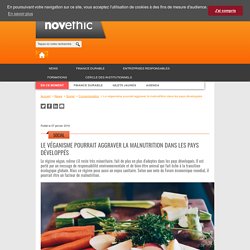
Kiwi, sarrasin, lait de chèvre : Mieux informer sur les allergies « émergentes » (Anses) Kiwi, sarrasin, lait de chèvre 15.02.19 allergies.
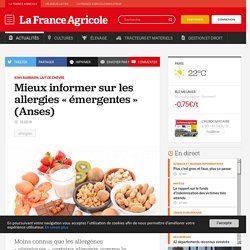
Association Between Ultraprocessed Food Consumption and Risk of Mortality Among Middle-aged Adults in France. Key Points Question Is high consumption of ultraprocessed food associated with an increase in overall mortality risk?
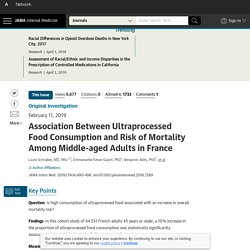
Findings In this cohort study of 44 551 French adults 45 years or older, a 10% increase in the proportion of ultraprocessed food consumption was statistically significantly associated with a 14% higher risk of all-cause mortality. Meaning An increase in ultraprocessed food consumption may be associated with an overall higher mortality risk; further prospective research is needed to confirm these findings. Importance Growing evidence indicates that higher intake of ultraprocessed foods is associated with higher incidence of noncommunicable diseases. However, to date, the association between ultraprocessed foods consumption and mortality risk has never been investigated.
Precision nutrition: hype or hope for public health interventions to reduce obesity? Skip to Main Content Sign In Register Close Advanced Search.
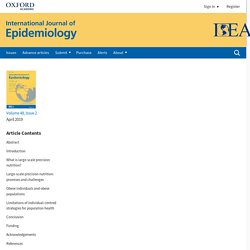
Valeurs nutritionnelles de référence : outil interactif en ligne. Antibiorésistance : Les prochains défis de la recherche. Mais la bataille s’annonce complexe. La raison principale : les bactéries résistantes sont partout, chez l’Homme, l’animal et dans l’environnement. Bilan : lutter contre antibiorésistance nécessite une approche globale dite One Health, littéralement "une seule santé". Les défis à venir sont donc nombreux et pour les relever, le programme prioritaire se décline en quatre axes de recherche "qui seront menés de front et de manière interdisciplinaire, c’est-à-dire en santé humaine, animale, mais aussi en incluant l’environnement et les sciences humaines et sociales, précise Evelyne Jouvin-Marche. Les controverses biochimiques du régime cétogène. Dans un contexte d’un intérêt croissant pour le régime cétogène, les scientifiques s’intéressent de plus en plus au bêta-hydroxybutyrate.
Activité physique, prévention et traitement des maladies chroniques – Une expertise collective de l’Inserm. Les maladies chroniques sont des affections non transmissibles de longue durée, parfois permanentes, qui évoluent avec le temps. Selon l’OMS, elles sont la première cause de mortalité mondiale et en Europe elles « concourent à près de 86 % des décès (…) et pèsent de plus en plus lourdement sur les systèmes de santé, le développement économique et le bien-être d’une grande partie de la population, en particulier chez les personnes âgées de 50 ans et plus ».
En France, la part des personnes âgées de 60 ans et plus devrait passer d’un quart en 2015 à un tiers de la population en 2040. Actes du colloque « Contaminants alimentaires : approches émergentes pour connaître et prévenir le risque » Un nouvel outil de suivi de la glycémie plus précis et moins douloureux pour les diabétiques. La méthode la plus courante pour suivre la glycémie chez les diabétiques est de procéder plusieurs fois par jour à un test sanguin en se piquant le bout du doigt. Healthy food diversity and supermarket interventions: Evidence from the Seacroft Intervention Study. JavaScript is disabled on your browser. Please enable JavaScript to use all the features on this page. Highlights Uniquely utilise food diary data from seminal supermarket intervention study. Unconditional quantile regression captures dietary impact across health distribution. Supermarkets can raise diversity, particularly for those with lowest levels.
Dietary behaviour reinforced; unhealthy item accessibility lowers healthful diversity. Education and healthier taste promotion more effective than supermarkets alone. Advanced school nutrition programs are effective, argue researchers. Students in schools with enhanced support to implement nutrition policies had an increase in BMI percentile of less than 1% during their four years in middle school, compared with students in schools without enhanced support for these policies and programs who demonstrated increases of 3% to 4%, according to study results. The observed 3% to 4% difference in mean BMI percentile is equivalent to a difference of about 2 lbs.
While 2 lbs may seem like negligible weight increase for a young child over four school years, researchers claimed that slowing weight gain in adolescence is clinically important to prevent adult obesity and if this trajectory is sustained over time, weight gain would substantially increase risk for severe comorbid conditions associated with overweight and obesity, such as metabolic and cardiovascular risks, as well as musculoskeletal disorders, depression, and more.
Spirulina may boost effects of exercise for obese individuals: RCT. Data published in the Marine Drugs showed that 4.5 grams per day of Arthrospira (Spirulina) maxima plus systematic physical exercise led to greater weight loss, the time to reach fatigue, and the onset of lactate build-up in the blood, compared to exercise alone. “This study is the first to focus on examining the effects of S. maxima supplementation in body composition in humans using a double-blind, randomized, crossover trial design,” reported scientists from the Universidad Autónoma de Ciudad Juárez (Mexico), Universidad Nacional Autónoma de Mexico (Mexico City), and the Universidad Autónoma de Chihuahua. Cardiovascular disease and nutrition: Almost half deaths in Europe ‘preventable’ The researchers, from Friedeich Schiller University Jena, looked at representative data from the Global Burden of Disease study, which was conducted between 1990 and 2016.
Healthy Returns: Opportunities for marked-based solutions to childhood obesity. Juices have hazardous amounts of heavy metals, study finds. Dive Brief: Consumer Reports tested 45 different juices on the market and found elevated levels of heavy metals — cadmium, lead, mercury and inorganic arsenic — in 21 of them, according to a new report. Livre blanc : « les dates de péremption, une idée dépassée ? » Gaspillage alimentaire et dates de péremption, quel est le problème? 10 % du gaspillage alimentaire ! À elles seules, les dates de péremption représentent 10 % du gaspillage alimentaire en Europe : elles jouent donc un rôle clef dans la lutte anti gaspi.
Réflexions sur la classification des aliments selon leur degré de transformation (classification NOVA) Relationship between sensory liking for fat, sweet or salt and cardiometabolic diseases: mediating effects of diet and weight status. Acknowledgements We thank the scientists, dieticians, technicians and assistants who helped carry out the NutriNet-Santé study, and all dedicated and conscientious volunteers.
We especially thank Mohand Aït-Oufella, Paul Flanzy, Yasmina Chelghoum, Véronique Gourlet, Nathalie Arnault and Laurent Bourhis. We thank Voluntis (a healthcare software company) and MXS (a software company specializing in dietary assessment tools) for developing the NutriNet-Santé web-based interface according to our guidelines. Author contributions. An inverse association between the Mediterranean diet and bladder cancer risk: a pooled analysis of 13 cohort studies. Cardiovascular mortality attributable to dietary risk factors in 51 countries in the WHO European Region from 1990 to 2016: a systematic analysis of the Global Burden of Disease Study.
Using data of the GBD Study 2016 [3], we examined the impact of dietary risks on CVD mortality in the WHO European Region in the period from 1990 to 2016. Although the age-standardized death rates decreased in all considered subregions between 2010 and 2016, the absolute number of diet-related premature cardiovascular deaths increased in 29 (out of 51) countries, with increases in Western Europe by 25,600 and in Central Asia by 4300 deaths (Fig. 2, Supplementary Appendix and in Appendix Table 5). Moreover, in 32 (out of 51) countries, increases in absolute diet-related CVD mortality were observed in adults younger than 70 years, leading to an additional 20,000 deaths in 2016 compared to 2010. With 22.4% of overall mortality and 49.2% of CVD mortality, dietary factors contribute substantially to the disease burden in the WHO European Region. Red meat, processed meat, and other dietary protein sources and risk of overall and cause-specific mortality in The Netherlands Cohort Study.
In this large prospective study, higher processed meat intake was significantly related to higher overall mortality risk in men and women during 10 years of follow-up in men and women aged 55–69 years at baseline, after adjusting for confounders. When comparing subjects in the highest versus lowest intake quintile, the HR for total mortality was 1.21.
Significantly positive associations were observed for cardiovascular (HR Q5 vs. Q1, 1.26) and respiratory mortality (HR = 1.79), but not for cancer mortality. Nutritional Labelling in the EU: Strengths and Weaknesses of the Current Regulatory Framework - Cavaliere - 2018 - EuroChoices. Nährwertinformationen auf Lebensmittelverpackungen können eine positive Wirkung auf die Kaufentscheidungen der Verbraucherinnen und Verbraucher haben. Sie ermöglichen eine bessere Einschätzung darüber, ob ein Lebensmittel gesund ist und können daher zu bewussteren und gesundheitsorientierteren Kaufentscheidungen führen. Les aliments ultra-transformés, un concept utile pour la santé publique. In this issue, we publish an article that introduces the idea of ultra-processed foods and the relationship that exists at the population level between the consumption of these foods and obesity.
This concept is tied to a rating scale (Nova) of the degree of industrialization of foods eaten today. The Nova scale was introduced about 10 years ago through the work of Carlos Augusto Monteiro’s team in Brazil (Monteiro 2009). It consists of a most pertinent and interesting concept and scale that provide for the establishment of links between the world’s food systems, nutrition, and public health, to guide consumers in their food choices. The impact of food reformulation on nutrient intakes and health, a systematic review of modelling studies. Quantifying the imprecision of energy intake of humans to compensate for imposed energetic errors: A challenge to the physiological control of human food intake.
Depression and eating styles are independently associated with dietary intake. Le FSAI dispose désormais d’un nouvel outil d'analyse de l’ADN d’un aliment. L’indice de masse corporelle, un bon outil pour savoir si son poids est sain ? Les bactéries, nos alliées pour vieillir beau ? Porcelet, bactéries et antibiorésistance : un trio dangereux pour la santé humaine. Longitudinal analysis of biomarker data from a personalized nutrition platform in healthy subjects. Special Issue. Diet and Health. The dual burden of malnutrition in the United States and the role of non-profit organizations. Veganism, vegetarianism, bone mineral density, and fracture risk: a systematic review and meta-analysis. Depressive Symptoms and Vegetarian Diets: Results from the Constances Cohort. Nanosized food additives impact beneficial and pathogenic bacteria in the human gut: a simulated gastrointestinal study.
Machine Learning au service de l'épidémiologie : ciblage des restaurants à inspecter par les services sanitaires aux États-Unis. Machine-learned epidemiology: real-time detection of foodborne illness at scale. Obesity and cancer risk: Emerging biological mechanisms and perspectives. Une piste pour réduire l’absorption des graisses par l’intestin. Troubles du sommeil et diabète de type 2 : quels sont les liens ? Un premier atlas du métabolisme circadien. To What Extent Memory Could Contribute to Impaired Food Valuation and Choices in Obesity? Activité physique et pratique sportive pour toutes et tous. Flowers in food ‘give rise to health concern’ Nearly 8% of US children have food allergies, study finds. Potential impacts of climate change on child stunting. One Blue Dot: Environmentally sustainable diets toolkit. Consumption of ultra-processed food products and diet quality among children, adolescents and adults in Belgium.
Cancers related to lifestyle and environmental factors in France in 2015 - European Journal of Cancer. Editorial praises childhood obesity study that finds 'genes are not destiny' Accounting for consumersâ preferences in the analysis of dietary recommendations. Dietary reference values: interactive tool goes live. Some differences in nutritional biomarkers are detected between consumers and non-consumers of organic foods: findings from the BioNutriNet Project. Création de l’Institut de la longévité, des vieillesses et du vieillissement.
Implications nutritionnelles des directives françaises sur l’offre alimentaire en restauration scolaire et place des plats protidiques. Mediterranean diet and its components in relation to all-cause mortality: meta-analysis. L’Anses et le CEA s’allient pour renforcer l’innovation technologique au service de la sécurité sanitaire. Food Additives and Child health. Ready-meal consumption in older people: association with obesity and dietary intake. The Global Nutrient Database: availability of macronutrients and micronutrients in 195 countries from 1980 to 2013 - The Lancet Planetary Health. Alcohol use and burden for 195 countries and territories, 1990–2016: a systematic analysis for the Global Burden of Disease Study 2016 - The Lancet. Anthropological and socioeconomic factors contributing to global antimicrobial resistance: a univariate and multivariable analysis - The Lancet Planetary Health.
Podcast : Avoir le cerveau plus gros que le ventre ? Nutrition disparities and the global burden of malnutrition. Association Between Ultra-Processed Food Consumption and Functional Gastrointestinal Disorders: Results From the French NutriNet-Santé Cohort. SMEREP enquete sante 2018 20180625 V4. Objective understanding of Nutri-Score Front-Of-Package nutrition label according to individual characteristics of subjects: Comparisons with other format labels. Nutritional quality of food as represented by the FSAm-NPS nutrient profiling system underlying the Nutri-Score label and cancer risk in Europe: Results from the EPIC prospective cohort study. Relationship between diet, the gut microbiota, and brain function.
Factors that contribute to effective nutrition education interventions in children: a systematic review. Novel public–private partnerships to address the double burden of malnutrition. Serving Size and Nutrition Labelling: Implications for Nutrition Information and Nutrition Claims on Packaged Foods. Examining the Nutritional Quality of Canadian Packaged Foods and Beverages with and without Nutrition Claims. Microbiome ‘breakthrough’ could drive development of personalised plans to fight fat. Micronutrient gaps in childbearing years ‘concerning,’ survey stresses. Gut bacteria byproduct protects against Salmonella, Stanford study finds. Un site internet unique pour améliorer le retrait-rappel des produits - L'Usine Agro. Géographie et santé publique, une alliance vitale. Inégalités sociales de santé et environnements favorables à une alimentation saine. La Santé en action n° 444 - sommaire.
Nutritional quality of fish and squid reduced by warm water events - Food & Beverage. EXPPERT 10 : nouveau rapport de Générations Futures sur les pesticides perturbateurs endocriniens dans l'alimentation.